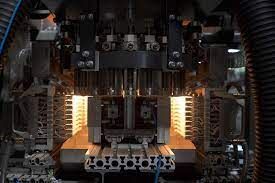
Types Of Machines That Are Commonly Used In Blow Molding
Types Of Machines That Are Commonly Used In Blow Molding

Blow molding is a plastic production process that the plastic production industry employs to manufacture hollow things composed of plastic. It is similar to other molding procedures as plastic product manufacturers carry blow molding by using heated fluid substances forced inside a mold cavity after being exposed to pressure. Blow molding machines can also blow mold polypropylene and manufacture polypropylene bottles. Thus people can call them polypropylene bottle production machines or PP bottle production machines.
There are many kinds of blow molding. One of those kinds is the extrusion blow molding which plastic product makers perform by squeezing out heated plastic into a parison. Injection molding is another kind of blow molding. Plastic bottle makers use one or two phases to manufacture plastic bottles. It is specifically efficient to create plastic bottles’ preforms, which bottle makers can use to make plastic bottles. The third kind of blow molding is injection stretch blow molding. Injection stretch blow molding is a procedure plastic product makers use to produce largely hollow things with rotational symmetry utilizing polymers.
1. Continuous Blow Molding Extrusion Machine (Generally Bottle Machines)
The meaning of continuous extrusion is that the extruder consistently manufactures a parison, i.e., tube out of its head. The halves of the mold then grasp the parison and move it to a blow molding station where the air molds the component to the mold’s configuration. Plastic product makers often employ continuous extrusion blow molding machines to manufacture smaller-sized plastic commodities in small quantities.
2. Accumulator Head Blow Molding Machine
Plastic product makers use the accumulator head blow molding machine to produce industrial parts in which the accumulation of the melted material is done inside the head and then moved out from the head with the help of cylinders.
3. Reciprocating Screw Blow Molding Machine
This machine comprises semi-injection equipment and a semi-accumulator head machine. They initially melt the plastic, collect the shot in the screw’s front, push it out over the mandrel developing the parison, and then form the component in the same way as type 1 and type 2. The reciprocating screw extruder’s use features reciprocating screw blow molding machinery.
Injection Blow Machine Or IBM's
These machines combine a blow molding machine and an injection molding machine. The first squirt liquefied plastic substance into a closed mold (steel), developing a preform. Then this equipment opens its lock and guides the preform on a spindle to an injection blowing station where the application of the air is done to the bottle into the desired shape. The machinery then guides a second time to an ejection station.
Two-Step Re-Heat And Blow Machine Or RHB
In this procedure, an injection molded preform is decoded, put into a serpentine belt system, and re-heated. (The quartz heaters program the re-heating to permit the precise form to more easily blow whenever it reaches the mold cavities.) After getting the mold cavities, a rod pushes the parison, enlarging it; the blow air supply is done through the container’s mouth, extending the preform in several directions simultaneously. This develops a bi-axially oriented commodity that can provide a carbon dioxide barrier, creating a typical pop bottle.
One-Step Blow Molding Machine
This process is like the above injection blow molding procedure ( #4) in that a preform is molded in the first stage mold halves, inscribed to a second stage, and blown and stretched simultaneously as in step No 5.
List Of Materials Which Can Be Blow Molded
The particular substances that are blow molded in general are (polyethylene terephthalate),HDPE (high density polyethylene),HWPE (high molecular weight polyethylene),Nylon ,ABS (acrylonitrile butadiene styrene),PVC (polyvinyl chloride),Polycarbonate. These particular substances. Manufacturers choose these materials for blow molding because of their physical qualities, environmental utilization, and cost.
Characteristics Of Blow Molding Machines
The sizing of a specific blow molding machine relies on the weight of its part and the flash of the part (if flashed), and the resin’s specific molecular weight. A plastic product maker must first know that if the blow molding machine almost weighs nearly one and a half kilograms cycles in about forty-eight seconds, then that manufacturer can mold high-density polyethylene material and, usually, molded on a double cavity or a single cavity. The important point in the above example is that the commodity with a finished weight of one thousand and five hundred grams has a flashed weight of around two thousand to two thousand one hundred grams.
Therefore a five-pound blow molding machine (accumulator's head) is essential to mold a product. It could also be molded in a reciprocating machine and in continuous extrusion equipment. In the case of continuous extrusion equipment, it becomes a little more challenging to determine the necessary size.
In every case, the platens should be huge enough to accommodate a mold. With continuous extrusion, manufacturers must comprehend that the output is incessant. Thus, people must know the product’s cycle time to decide the pounds per hour that the extruder must manufacture.
All of the above is a very superficial elaboration of the magnitude of the blow molding apparatuses versus the product’s nature. An extra factor that plays its role is the head’s ability to house the tools which make the parison the right diameter.
Conclusion
As people might well comprehend, a few paragraphs are insufficient to discuss the blow molding technology. The above details are provided to help plastic product makers decide the size of the machinery they need to carry out the blow molding job.
